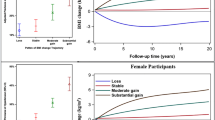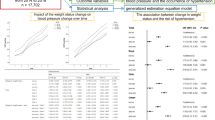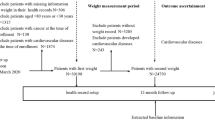Abstract
This study aimed to investigate the effect of body mass index (BMI) changes on hypertension among rural areas of China. A population-based sample of 13,263 and 5944 rural Chinese people aged ≥35 years and without hypertension at baseline was included in our analysis of BMI changes (from (2004–2006) to 2008) and short- and long-term outcomes of hypertension (from 2008 to 2010 and 2010 to 2017). The participants were divided into four groups by a comprehensive cross-sectional combination according to baseline BMI (18.5–24 vs. ≥24 kg/m2) and follow-up changes (decreased vs. increased). Adjusted Cox proportional hazards models were used to estimate hazard ratios (HRs) and 95% confidence intervals (95% CIs). During a median follow-up period of 4.8 (short-term) and 11.7 (long-term) years, 2299 (17.33%) and 2020 (33.98%) participants developed hypertension, respectively. For participants with a baseline BMI ≥ 24 kg/m2, when BMI decreased in follow-ups, the multivariable-adjusted HRs (95% CI) of short-term hypertension were 0.898 (0.857–0.942). For baseline 18.5 kg/m2 ≤ BMI < 24 kg/m2, when BMI increased in follow-ups, the risks of short-term hypertension were 1.103 (1.068–1.139). We detected that BMI changes had a lower impact on the incidence of hypertension in long-term than short-term. Our study indicated that BMI changes were significantly associated with the incidence of hypertension for the short-term, and it had a stronger impact on short-term outcomes than long-term. Managing weight by lifestyle modification was particularly important for the primary prevention of hypertension in rural Chinese population.
This is a preview of subscription content, access via your institution
Access options
Subscribe to this journal
Receive 12 digital issues and online access to articles
$119.00 per year
only $9.92 per issue
Buy this article
- Purchase on Springer Link
- Instant access to full article PDF
Prices may be subject to local taxes which are calculated during checkout



Similar content being viewed by others
References
NCD Risk Factor Collaboration (NCD-RisC). Trends in adult body-mass index in 200 countries from 1975 to 2014: a pooled analysis of 1698 population-based measurement studies with 19.2 million participants. Lancet. 2016;387:1377−96.
Kearney PM, Whelton M, Reynolds K, Muntner P, He J. Global burden of hypertension: analysis of worldwide data. Lancet. 2005;365:217–23.
Wang J, Zhang L, Wang F, Liu L, Wang H.China National Survey of Chronic Kidney Disease Working Group Prevalence, awareness, treatment, and control of hypertension in China: results from a national survey. Am J Hypertens. 2014;27:1355–61.
Wu Y, Huxley R, Li L, Anna V, Xie G, Yao C. et al. Prevalence, awareness, treatment, and control of hypertension in China: data from the China National Nutrition and Health Survey 2002. Circulation. 2008;118:2679–86.
Yang G, Wang Y, Zeng Y, Gao GF, Liang X, Zhou M, et al. Rapid health transition in China, 1990−2010: findings from the Global Burden of Disease Study 2010. Lancet. 2013;381:1987–2015.
Zheng Y, Manson JE, Yuan C, Liang MH, Grodstein F, Stampfer MJ, et al. Associations of weight gain from early to middle adulthood with major health outcomes later in life. JAMA. 2017;318:255–69.
Xu X, Hall J, Byles J, Shi Z. Dietary pattern is associated with obesity in older people in China: data from China Health and Nutrition Survey (CHNS). Nutrients. 2015;7:8170–88.
Kawada N, Nakanishi K, Ohama T, Nishida M, Yamauchi-Takihara K, Moriyama T. Gender differences in the relationship between blood pressure and body mass index during adolescence. Obes Res Clin Pr. 2015;9:141–51.
Chen H, Dai J. BMI better explains hypertension in Chinese senior adults and the relationship declines with age. Aging Clin Exp Res. 2015;27:271–9.
Lissner L, Odell PM, D’Agostino RB, Stokes J 3rd, Kreger BE, Belanger AJ, et al. Variability of body weight and health outcomes in the Framingham population. N Engl J Med. 1991;324:1839–44.
Ren Q, Su C, Wang H, Wang Z, Du W, Zhang B. Change in body mass index and its impact on incidence of hypertension in 18−65-year-old Chinese adults. Int J Environ Res Public Health. 2016;13:257.
Zhao Y, Liu Y, Sun H, Sun X, Yin Z, Li H, et al. Association of long-term dynamic change in body weight and incident hypertension: The Rural Chinese Cohort Study. Nutrition. 2018;54:76–82.
Neter JE, Stam BE, Kok FJ, Grobbee DE, Geleijnse JM. Influence of weight reduction on blood pressure: a meta-analysis of randomized controlled trials. Hypertension. 2003;42:878–84.
Zheng L, Sun Z, Zhang X, Li J, Hu D, Chen J, et al. Predictive value for the rural Chinese population of the Framingham hypertension risk model: results from Liaoning Province. Am J Hypertens. 2014;27:409–14.
Zheng L, Zhang Z, Sun Z, Li J, Zhang X, Xu C, et al. The association between body mass index and incident hypertension in rural women in China. Eur J Clin Nutr. 2010;64:769–75.
Hossain MG, Saw A, Alam R, Ohtsuki F, Kamarul T. Multiple regression analysis of anthropometric measurements influencing the cephalic index of male Japanese university students. Singap Med J. 2013;54:516–20.
Decoda Study Group, Nyamdorj R, Qiao Q, Lam TH, Tuomilehto J, Ho SY, et al. BMI compared with central obesity indicators in relation to diabetes and hypertension in Asians. Obesity (Silver Spring). 2008;16:1622–35.
Brown CD, Higgins M, Donato KA, Rohde FC, Garrison R, Obarzanek E, et al. Body mass index and the prevalence of hypertension and dyslipidemia. Obes Res. 2000;8:605–19.
Gordon B, Shamiss A, Derazne E, Tzur D, Afek A. Sex differences in the association between body mass index and hypertension—a cross-sectional study in 717 812 adolescents. Pediatr Obes. 2016;11:317–20.
Adler C, Schaffrath Rosario A, Diederichs C, Neuhauser HK. Change in the association of body mass index and systolic blood pressure in Germany—national cross-sectional surveys 1998 and 2008-2011. BMC Public Health. 2015;15:705.
Droyvold WB, Midthjell K, Nilsen TI, Holmen J. Change in body mass index and its impact on blood pressure: a prospective population study. Int J Obes (Lond). 2005;29:650–5.
Luo W, Chen F, Guo Z, Wu M, Hao C, Zhou Z, et al. Comparison of the suitability of 2 years change in waist circumference and body mass index in predicting hypertension risk: a prospective study in Chinese-Han. Iran J Public Health. 2014;43:1212–20.
Shihab HM, Meoni LA, Chu AY, Wang NY, Ford DE, Liang KY, et al. Body mass index and risk of incident hypertension over the life course: the Johns Hopkins Precursors Study. Circulation. 2012;126:2983–9.
Ohkuma T, Woodward M, Jun M, Muntner P, Hata J, Colagiuri S, et al. Prognostic value of variability in systolic blood pressure related to vascular events and premature death in type 2 diabetes mellitus: the ADVANCE-ON Study. Hypertension. 2017;70:461–8.
Gosmanova EO, Mikkelsen MK, Molnar MZ, Lu JL, Yessayan LT, Kalantar-Zadeh K, et al. Association of systolic blood pressure variability with mortality, coronary heart disease, stroke, and renal disease. J Am Coll Cardiol. 2016;68:1375–86.
Zhou Z, Hu D, Chen J. Association between obesity indices and blood pressure or hypertension: which index is the best? Public Health Nutr. 2009;12:1061–71.
Acknowledgements
All of the investigators and staff members were gratefully acknowledged. Thanks for all the enthusiastic participants.
Funding
This research was partly supported by funds from National Nature Science Foundation of China (No. 81773510), National Key R&D Program of China (Grant #2017YFC1307600), and National Key R&D Program of China (Grant #2018YFC1311600).
Author information
Authors and Affiliations
Corresponding authors
Ethics declarations
Conflict of interest
The authors declare that they have no conflict of interest.
Additional information
Publisher’s note Springer Nature remains neutral with regard to jurisdictional claims in published maps and institutional affiliations.
Rights and permissions
About this article
Cite this article
Gao, Z., Wang, Y., Dai, Y. et al. Association between body mass index changes and short- and long-term outcomes of hypertension in a Chinese rural cohort study. J Hum Hypertens 34, 593–601 (2020). https://doi.org/10.1038/s41371-019-0276-x
Received:
Revised:
Accepted:
Published:
Issue Date:
DOI: https://doi.org/10.1038/s41371-019-0276-x
This article is cited by
-
Longitudinal association between physical activity and blood pressure, risk of hypertension among Chinese adults: China Health and Nutrition Survey 1991–2015
European Journal of Clinical Nutrition (2021)



